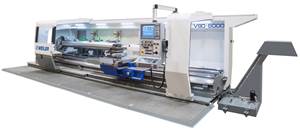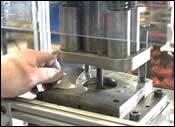Lean Manufacturing For The Job Shop
Lean practices are not just for predictable production. Here are the common-sense ways this low-volume job shop has implemented a leaner process.
“Ninety percent of ‘lean’ is useless to us,” says Tricia Gerak, CEO of Canton, Ohio-based Precision Component Industries.
Precision Component is a job shop specializing in high-end, low-volume, complex parts made from hard-to-machine materials. Much of the shop’s work, for example, relates to hardware for precision military systems. Lean machining tends to accept cycle time as a given, optimizing the surrounding process to minimize inventory and waste. Setup time reduction is an important component of this. However, for Precision Component, setup time is a given as well. Many of the shop’s jobs are short-run parts for which the setup has to be invented on the fly. For this reason and others, Ms. Gerak assumed that the disciplines of lean manufacturing had nothing to offer her shop.
Then she attended a session on lean as part of a supplier seminar held by a major defense contractor. She posed questions to this session’s presenter. He was astute enough to perceive how her shop’s situation was different, and he interpreted lean principles for her in light of how a low-volume job shop might apply them. That conversation changed her thinking.
“I realized I had to let go of my paradigm that lean didn’t make sense for the job shop,” she said.
In fact, there was a part of lean that did make sense. Specifically, there was the other ten percent.
Clearing The Aisles
Anthony Gerak is president of Precision Component. He and Ms. Gerak committed to streamlining both the business and the shop floor in light of their new understanding of lean, and they explained these changes to the company’s staff. To begin, they cited the many well-known aspects of lean that they would not be implementing. There would also be no kaizen events, they said. There would be no 5S, and the shop would not even install peg boards. That’s because the range of potential jobs is so vast that the range of tools needed is unpredictable.
However, there would still be fundamental change. One of the most striking examples is a move to a more lean approach to ordering raw material. The purchasing manager used to order stock as soon as the production order was received from the customer. The perceived advantage was that the shop would have the stock on hand “just in case” it had a chance to run this job. Pallets of raw stock crowded the aisles of the shop floor.
Today, the aisles are clear—but that means they are also clear of this reassuring visual evidence of the shop’s backlog. Employees wondered: Does the shop still have plenty of work?
Absolutely yes, the Geraks explained. They went on to explain the reason for the change—a reason they now see as common sense. In the past, the shop had not stopped to consider just how much money it was spending to own and store that material. Today, the plant manager and the purchasing manager coordinate their actions. Material is ordered no earlier than two days before it is needed. As a result, all of that capital that used to be tied up in raw material is set free for a more productive use, such as investing in additional tooling and equipment.
“I Had To Go Find X”
Streamlining processes on the shop floor came next. To do this, the shop simply looked at one recurring job that had a variable processing time to discover where the variability was coming from. From this, the shop learned a great deal about where time was being lost on all of its jobs.
In analyzing how shopfloor personnel spent their time, a common theme emerged. To account for one instance of a job running long, the operator said, “I had to go find the right gage.” In another case: “I had to go find a toolholder.” Operators were walking the shop floor in search of the tools, hardware and accessories they needed. The solution to this problem was to purchase more of all of these items so that whatever operators needed could always be close at hand.
The Geraks now stress this important point to employees: Whatever you are looking for is not as valuable as the time you spend looking for it.
The appearance of frugality can be deceptive, they say. When the shop acquired its most recent machine, a used Mazak Integrex 50 multitasking machine able to run workpieces as long as 100 inches, the management decided to buy new toolholders that would be dedicated to it. Employees questioned the need because there seemed to be enough toolholders in the shop. However, it would be far less expensive in the long run simply to have plenty of toolholders, Ms. Gerak says. She adds, “If I can spend $1,000 on tooling to save 30 minutes per day of walking around, then that is easily worth the expense.”
In fact, because they are not searching, employees now have time they didn’t have before. While the machines are running, they can now stage the next job and the job after that. Staging jobs in this way ultimately revealed another shortage that was leading to waste. Operators were walking the floor searching for the belted straps that wind around large workpieces so the crane can lift them. The shop was short on straps—a simple, low-cost item. Employees spent labor cost on looking for straps because looking around was such a common part of the shop’s practice. Now, the shop has decisively remedied this problem simply by purchasing many more straps for the shop floor.
Move To Multitasking
The move to multitasking machines such as the latest Integrex began when the shop purchased a smaller Integrex machine in 2004. In addition to realizing it could benefit from multitasking, the shop discovered that its CAM system, GibbsCAM, makes it relatively easy to program even this more complex type of machine.
Many production facilities would not see a multitasking machine such as this as being consistent with their application of lean manufacturing. One station where a lot of machining is performed could be seen as a “monument”— a place where parts queue because batching is necessary to hold down the unit cost of this work. For established parts in predictable production, a series of simple stations can often avoid this work-in-process inventory.
However, that doesn’t describe Precision Component. Many of this shop’s jobs involve short runs of complex parts that were unknown to the shop just days prior. Batching these jobs isn’t a danger—the quantities are too low. Running jobs such as these in one setup on a multitasking machine has proven to be much more efficient than setting up the part first on a lathe, then on a machining center. Thanks to the shop’s growing reliance on multitasking, machining centers now run just one shift instead of three.
More Multitasking
In fact, multitasking of a higher order represents the direction in which the shop now finds itself headed. Instead of stopping at just machining the components, one major customer has asked the shop to also assemble the finished product. That product (a specialized machine—the shop asked to keep its nature confidential) is now built on the shop floor to the customer’s specification, then sent to the customer complete.
The result could be thought of as lean manufacturing from the customer’s perspective, because the customer’s ordering process has become much more streamlined. Instead of making separate expenditures for separate manufacturing steps, Mr. Gerak says this customer can now obtain the fully manufactured product for just one line item on a purchase order.
Related Content
When Organic Growth in Your Machine Shop Isn’t Enough
Princeton Tool wanted to expand its portfolio, increase its West Coast presence, and become a stronger overall supplier. To accomplish all three goals at once, acquiring another machine shop became its best option.
Read MoreA New Milling 101: Milling Forces and Formulas
The forces involved in the milling process can be quantified, thus allowing mathematical tools to predict and control these forces. Formulas for calculating these forces accurately make it possible to optimize the quality of milling operations.
Read MoreModern Bar Feeds Bring New Life to Automatic Swiss Lathes
Cam-actuated Swiss lathes are still the fastest way to process many parts. By adding modern bar feeders, this shop has dramatically improved their utilization with the ability to work unattended, even in a lights-out environment.
Read MoreWeiler to Debut New Automation Features For Its Lathes
Weiler’s V 110 four-way precision lathe introduces features new to the U.S.
Read MoreRead Next
Why Boeing Is Big On Right-Size Machine Tools
Simple, dedicated machines save on capital expense, while they also make it possible to realize one-piece flow. These machines are often developed internally. 'Chaku-chaku' is the new ideal.
Read MoreThe Cut Scene: The Finer Details of Large-Format Machining
Small details and features can have an outsized impact on large parts, such as Barbco’s collapsible utility drill head.
Read More3 Mistakes That Cause CNC Programs to Fail
Despite enhancements to manufacturing technology, there are still issues today that can cause programs to fail. These failures can cause lost time, scrapped parts, damaged machines and even injured operators.
Read More
.jpg;width=70;height=70;mode=crop)




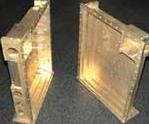

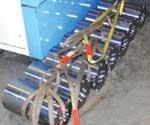




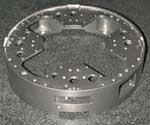







.png;maxWidth=300;quality=90)

.png;maxWidth=300;quality=90)












